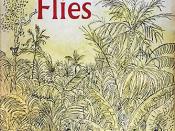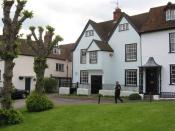Carlos Alfonso
Mrs. Russo
2/13/14
English 1
Social Cliques in Lord of the Flies by William Golding
Social cliques are both a blessing and a curse to adolescences in high school and even
in the real world. Cliques' help people find others that share common interest and allow
adolescences to make friends and find themselves. Though cliques can often turn violent and
exclude others because they do not share common interests they have become common place in
society and it is better to learn how to cope with them then to go against them. William Golding
uses a complex social hierarchy, a vivid character portrayal of abandonment and atonement, and
the use of friendship and betrayal in Lord of the Flies to accurately outline the causes and effects
of social cliques in adolescences.
"When we look at any society, whether primitive or highly developed, whether simple or
complicated, we observe conformities of behavior, within the limits of variations due to individual differences, on the part of the individual members of any society as they carry on the daily busyness of living"(Sheriff & Cantril).
Social cliques are prevalent even in primal or advanced societies, both groups have cliques appear on a regular bases. They are common enough in other animals that it has advanced far enough to be comparable to humans.
"In the bright glow and warm presence of the American Dream all men are born free
and equal"(Warner, Meeker, and Eells).Social cliques of status attempt to refute this statement by claiming one clique higher than another. Lord of the Flies by William Golding is a cult classic amongst the many great books of its era to explore this concept of clique domination.. The book follows Ralph as he and dozens of other small children are deserted on an
island after a nuclear explosion forces them out of England, though the island is fruitful and there
is no need to bicker over resources constant infighting leads the group of teens and children to
divide into 2 groups each with conflicting interest, Ralph's group and Jack's group (a fellow
abandoned boy who is the leader of a small group called the choir). All of the children in Ralph's
group betray him and join Jack; Ralph is hunted down and almost killed until the children are
rescued by a passing British naval officer and his ship. 2 children are dead and with their first
sight of an adult in months (or weeks, the book does not give an accurate portrayal as to how
long they were on the island exactly) they break out in tears and show that they are still children
and didn't really understand what they were doing to each other. They were feeding of their
primal desires and ended up killing for it. There are many reasons for the melt down that those
children have tried to build, from their immaturity, their hidden psychopathic nature and many
more.
"Groups can form around things people have in common" (Collins). There is often a clear
distinction between social cliques, for example the jocks in school almost never socialize with
the nerds, spazzes, or outcast. There is a missing link between these social classes, who have to
say that a person on a football team can't talk math with the braincases? The missing link as I
like to call it is often nonexistent, most kids stick to one cliques and rarely move to and from
them. This kind of rift between classes is based on a variety of things, wealth, social skills,
education, and home problems just to name a few.
William Golding introduces us to "the beastie" very early on in the book. He uses the
beastie to begin the construction of a rift between the two groups; the very first sign of cliques
beginning to form is when the beastie was first introduced. Some children wanted to hunt down
the beastie and kill it, others believed it didn't exist and was just a figment of a scared child's
imagination.
This first rift would eventually grow to the point were 2 kids will die and others will be
left mentally scarred for the rest of their lives. The beastie can be used to personify the difference
between social cliques. The reason the 2 groups begin to drift in the first place is their differing
opinions in handling the beastie. The beastie is also used to separate the maturity levels of the
survivors, it was very common that survivors with a higher level of maturity would join Ralph's
group as opposed to jacks because they see the logic that there is no beastie.
This is very similar to the intelligence barrier present in cliques today. It is often over
whelming the intelligence difference between students that aren't known for their studies and
those that are classified as "nerds". This effect plays a smaller part at the end of the book but is
prevalent enough in the beginning to make note of it.
"Unlike adults, children are a disenfranchised, powerless group in society"(Patricia Adler, Patrick Adler). In social cliques today there is often a presence of a leader
of the group, this "alpha male" (or female) is often the one must associated with zed clique.
These leaders can be seemed as the embodiment of the social clique themselves. Ralph and Jack
are the alpha males of the group. But the problem here is that there can't be two leaders this leads
to infighting, this is exactly what happens and this leads to friction and the eventual separation of
the two groups.
Leaders of the group usually make the most important decisions in relation to how they
function with other cliques. In Lord of the Flies case Jack decides to be violent towards Ralph
because he feels that he is more worthy of being chief then Ralph ( amongst other things), this
use of violence is the final pull that is needed to pull the two groups apart.
The threat of violence was malevolent all throughout the book, Jack has been dreaming
of being a hunter all throughout the book, thou in the beginning he really did not understand the
concept of taking a life, there is a very symbolic moment in the book where Jack puts on the face
paint he found when hunting, this face paint symbolizes the primal desires for food and meat and
the lengths he will go to get it. Jack later becomes accustomed to killing and hurting other living
beings, after he scores his first kill this violent nature of his grows, eventually he splits apart
from Ralph and makes his own village.
William Golding uses a complex social hierarchy, a vivid character portrayal of
abandonment and atonement, and the use of friendship and betrayal in Lord of the Flies to
accurately outline the causes and effects of social cliques in adolescences.
I believe that Mr. William Golding portrayed the issue of social cliques in adolescences
very well. He used many examples and related them to more personified and poetic forms that
made it easier yet more challenging to fully understand.
Works Cited
Warner, Meeker, and Eells Social Class in America: A Manual of Procedure for the Measurement of Social Status" www.questia.org, Web, 12/15/13, http://www.questia.com/library/1470096/social-class-inamerica-a-manual-of-procedure-for
Golding, William. Lord of the Flies. New York: Coward, McCann & Geoghegan, Inc., 1954.
Sherif & Cantril "The Psychology of Ego-Involvements: Social Attitudes & Identifications", www.questia.com, Web, 12/15/13, http://www.questia.com/library/729892/the-psychology-of-ego-involvementssocial-attitudes
Collins, "Development of Cognition, Affect, and Social Relations" www.babble.com, Web, 12/15/13,
http://www.questia.com/library/1310271/development-of-cognition-affect-and-social-relations
Patricia Adler and Patrick Adler "Peer Power: Preadolescent Culture and Identity", www.questia.com, Web, 12/15/2013,
http://www.questia.com/read/29158931/peer-power-preadolescent-culture-and-identity


